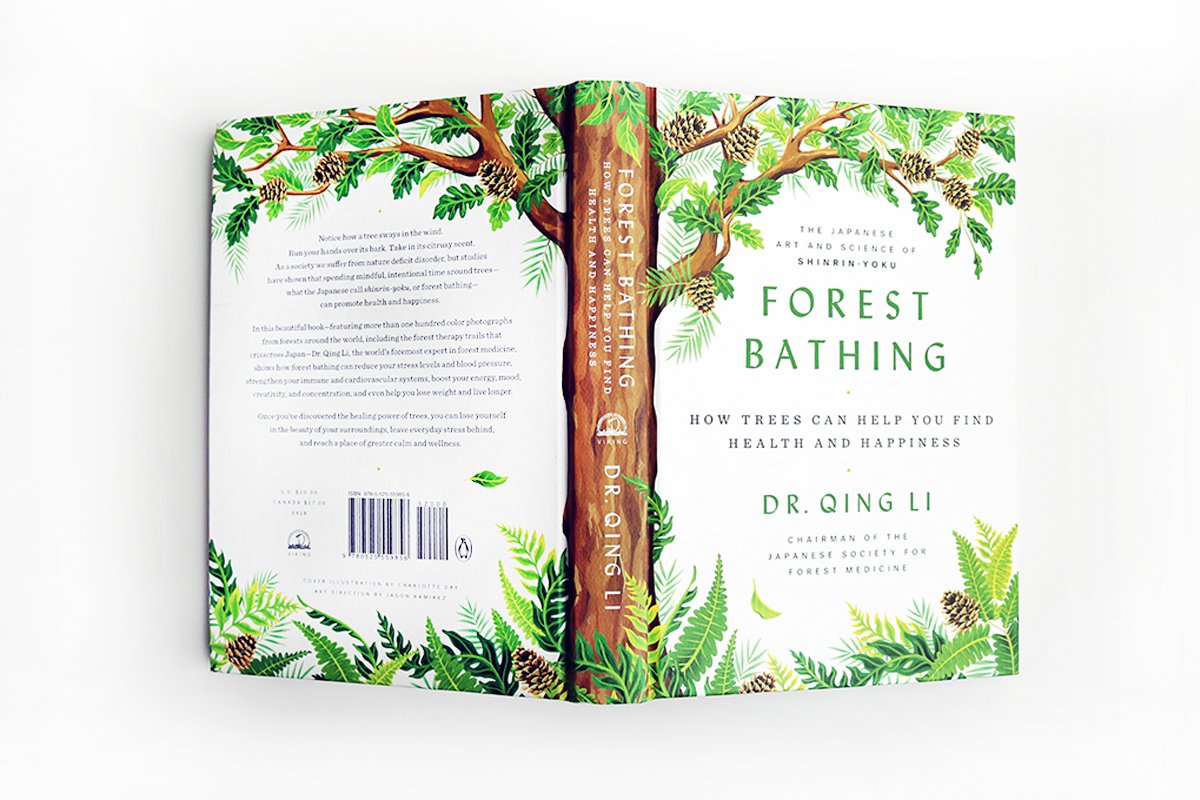Forest Bathing: The healing power of nature therapy

When you look at this photo of a forest, how does it make you feel?
What if you could hear the crunch of leaves and twigs under your feet, the birds singing and the trees rustling in the breeze?
What if you could smell the damp soil and fresh pine needles?
What if you could feel the cool air and the warmth of the dappled sunlight on your face?
This is the experience of forest bathing – awakening your senses to the fullness of the natural world.
Forest bathing has a wide range of health benefits, including strengthening your immune and cardiovascular systems, improving your energy and mood, and helping you to sleep more, lose weight, and potentially even live longer.
As someone who has spent a lot of time hiking in the beautiful native forests of New Zealand, I can attest to the mental benefits of forest bathing.
Nature has become my most reliable and consistent form of therapy and I’ve lost count of the times that a walk in the forest has lifted me out of a depression and recalibrated my mind.
We all know the healing power of nature. That’s why we say things like, “Let’s go outside and get some fresh air”. We know that being outside makes us feel better.
Forest bathing and the research around it helps us to understand why nature makes us feel better and how we can maximise its healing power in our lives.
Overview
- What is forest bathing?
- How to do forest bathing
- The science of forest bathing
- Why forest bathing works
- Forest bathing resources
What is forest bathing?
I know it sounds like taking a luxurious, wood-fired bubble bath in the middle of a secluded forest.
And while that does sound amazing, you don’t actually need a bath or a forest to go forest bathing.
I think it’s important to understand that forest bathing isn’t anything new. Humans have been hanging out in forests since we emerged as a species.
We’ve lived in forests longer than we’ve lived in cities.
But the concept of forest bathing only developed during the 1980s in Japan, where it’s known as Shinrin-Yoku.
The Japanese government funded research into the health benefits of spending time in nature as a potential antidote for our modern way of life.
The findings of that research and subsequent studies have provided valuable evidence for the health benefits of forest bathing.
That led to the Japanese government including Shinrin-Yoku in its national health program and doctors there routinely prescribe forest bathing to patients.
Forest bathing is the act of opening all of your senses to nature. Dr Qing Li, one of Japan’s leading Shinrin-Yoku researchers and author of the book Forest Bathing: How Trees Can Help You Find Health and Happiness describes it like this:
“It is simply being in nature, connecting with it through our senses of sight, hearing, taste, smell and touch.”
How to do forest bathing
Forest bathing does not require you to visit a proper wild forest. You simply need to be around a few trees, which could even be in your backyard or local park, and take some time to let all of your senses experience nature.
What does it look like?
What does it sound like?
What does it smell like?
What does it feel like?
What does it taste like?
The simple act of bringing your attention to nature can help you to heal, Dr Li says.
“Shinrin-yoku is like a bridge. By opening our senses, it bridges the gap between us and the natural world. And when we are in harmony with the natural world we can begin to heal. Our nervous system can reset itself, our bodies and minds can go back to how they ought to be. No longer out of kilter with nature but once again in tune with it, we are refreshed and restored.”
It’s as though consciously focussing on each of your senses has a meditative effect and draws you into the present moment.
I know it sounds a bit woo woo, but there is plenty of science to back these claims up.
Want to get The Now in your inbox? Sign up here.
The science of forest bathing

The Japanese government has invested millions of dollars into studying the scientific benefits of forest bathing.
So far, scientists have found that forest bathing has positive effects on a wide range of health conditions.
Simply being in a forest has been shown to reduce indicators of stress and anxiety, improve mood and immune system functionality (our innate ability to fight viruses, infections and even cancer).
These aren’t just isolated studies. Decades of research seems to support the idea that nature is a powerful healer.
Room with a view
First, I want to quickly jump back to a 1984 study of 46 patients recovering from gall bladder surgery in a Pennsylvania hospital.
That study found that patients that had rooms with windows looking out on a natural scene recovered faster and took fewer painkillers post-surgery compared with patients that had no view of nature.
The suggestion is that simply having a view of nature through a window can be therapeutic and aid the body’s healing process.
What about photos?..
Which brings me to a paper, published in 2015, that found that looking at photos of nature helped to reduce stress by activating the parasympathetic nervous system.
These were photos of parks and trees shown to people on a computer screen – pretty much akin to having a pretty desktop background.
I wanted to share these two studies because they set the stage for forest bathing.
If a window view from a hospital bed and digital images of nature can have measurable effects on human health, then what can a full sensory experience in the midst of nature do?
Forest medicine
Study 1: Forest bathing and relaxation
From 2005 to 2006 in Japan, 280 male university students took part in a forest bathing study.
The participants – 12 at a time – were taken to visit a forest area and a city area across 24 different parts of Japan.
As much as possible, conditions for each of the participants were kept the same.
When they arrived at each site, they were seated in chairs to take in the landscape for about 14 minutes followed by a walk for about 16 minutes.
Their blood pressure, pulse rate and heart rate variability was measured and saliva collected in the morning before breakfast and before and after each seated viewing and walk.
The results, published in 2009, found that forest environments could lower concentrations of cortisol (stress hormone), lower pulse rate, lower blood pressure, increase parasympathetic nerve activity, and lower sympathetic nerve activity compared with city settings.
“The results of the physiological measurements suggest that Shinrin-yoku can aid in effectively relaxing the human body,” according to the study.
Study 2: Forest bathing and chronic disease
In 2016, 19 men, ranging in age from 40 to 69 years, took part in a similar forest bathing study in Japan.
They first visited an urban area with almost no trees as a control. They walked 2.6 kilometres for 80 minutes in the morning and again in the afternoon.
A week later, they did the same thing in a forest area in central Japan.
Blood and urine were sampled in the morning before and after each trip. Cardiovascular and metabolic parameters were measured. Blood pressure and pulse rate were measured using an automatic monitor at the same time every 20 minutes during the trip.
Scientists also conducted the Japanese version of a Profile of Mood States (POMS) assessment with each of the participants before, during and after the trips.
The data found that forest bathing produced significant benefits compared to walking in an urban area, including:
- Decrease in pulse rate (suggests participants were calmer)
- Decrease in urinary dopamine and adrenaline (suggests participants were more relaxed)
- Increase in adiponectin in serum (regulates glucose levels and may help prevent obesity, type-2 diabetes and heart disease)
- Decrease in negative moods such as anxiety, depression, fatigue and confusion
- Increase in feelings of vigor (physical strength and good health)
While this is a fairly small sample size, the findings support the idea that spending time in a forest has a host of health benefits.
Study 3. Forest bathing and cancer
A 2008 study of 13 female nurses in Japan found that taking three two-hour walks in a forest over two days increased human natural killer (NK) cell activity, the number of NK cells, and levels of intracellular anti-cancer proteins.
In more simple terms, forest bathing enhanced the immune system’s ability to fight viruses and cancer.
What’s even more incredible is that these positive health effects lasted for at least a week after the trip.
The study suggested that phytoncides (wood essential oils) may partially contribute to increased NK activity (I’ll get into phytoncides more below).
An earlier study had similar results with male participants.
Study 4: Forest bathing and depression
In one of the most comprehensive studies to date, 155 people took part in 16 day-long forest bathing sessions over three years, between 2012 and 2014.
Of the 155 participants, 58 (or 37%) of them had depressive tendencies, based on the Kessler Psychological Distress Scale.
Participants visited a forest area in Japan in Spring or Autumn and spent two hours walking in the forest with a guide.
It’s worth noting that the guides also introduced breathing techniques, yoga exercises and hammock experiences to the participants, which likely influenced the results.
Physiological measurements, including blood pressure, pulse rate, circulation and autonomic nerve function, were done before and after forest bathing sessions. Psychological tests, including the POMS mentioned above, were also undertaken.
Study 5: Forest bathing outside Japan
Just in case you’re thinking, “Yeah yeah, but all those studies are in Japan”, I wanted to include this study from Australia, published in Nature magazine in 2016.
The study attempted to determine a minimum effective “dose” of forest therapy as treatment for high blood pressure and depression.
The study used data from self-reported online surveys from 1538 participants in Brisbane City, Australia. Over a week, they measured the frequency of outdoor green space visits, the duration of those visits, and the “intensity” of the nature.
Participants also reported back on their mental health, physical health, social health, and health behaviour (physical activity).
“We observed significantly fewer cases of depression and high blood pressure in people who spent an average of 30 minutes or more visiting green space in the survey week, and there was some indication that longer duration visits may be associated with an even lower prevalence of depression.”
This study suggests that spending as little as 30 minutes in nature a week can be an effective antidote for depression and prevent high blood pressure.
There are many more forest bathing studies out there, but these five show the wide-ranging benefits of nature therapy and well and truly supported by science.
Why forest therapy works
The question of why forest bathing works hasn’t really been explored in the scientific literature.
But I have my theories, some of which are supported by the science.
It’s in our genes
As I mentioned earlier, humans have lived in nature for longer than we’ve lived in towns or cities. Nature is an important part of our evolution.
Today, we have largely disconnected ourselves from nature. We live in houses or apartments in concrete jungles. We work in offices. We get our food from supermarkets or fast food restaurants. We exercise in gyms. We entertain ourselves with technology. We’re constantly surrounded by the sounds of traffic and city life.
In the context of our modern way of living, going to the forest is a radical act.
By leaving the city environment and visiting a natural environment we transport ourselves from a state of chaos to a state of calm.
There’s less noise, fewer people and fewer distractions.
Simply changing our environment gives our nervous system a chance to recalibrate and relax.
I also believe that humans have an innate evolutionary memory. It’s like our genes remember where they came from, that we are part of nature not separate from it. Going to the forest is like a homecoming. The colours, shapes, smells and feelings are innately familiar to us. We feel like we belong.
Those two factors alone – disconnecting from the modern world and feeling like we’re at home in the forest – would have healing and soothing effects on the mind and body similar to those identified in the forest bathing studies.
The aroma of the forest
It’s also likely that phytoncides, sometimes referred to as “the aroma of the forest”, have healing properties.
Phytoncides are antimicrobial essential oils excreted from trees to protect them from bacteria, insects and fungi. However, it seems that they also have health benefits for humans.
When we say that it feels good to breathe the fresh air in the forest, we might really mean that it feels good to inhale the phytocides of the forest.
The research on phytoncides isn’t yet conclusive, but there’s enough to suggest that they play a role in forest therapy.
A walk in the woods
Visiting nature typically involves taking a walk.
In the studies cited above, participants walked in the forest for between 16 minutes and two hours.
The physical and mental health benefits of walking are well established.
You could think of forest bathing as “walking on steroids”. You get all the benefits of walking around the block and a whole lot more.
Forest bathing is meditation
Finally, I see forest bathing as a form of meditation.
It requires you to connect with your body and be mindful of your senses.
It then asks you to focus your senses on one thing – the forest.
You’re focussed on what you can see, hear, smell, taste and touch in the moment. Your thoughts and worries about the day take a back seat.
That’s meditation.
The health benefits of meditation are conclusive. I suggest one of the reasons why forest bathing works is because it’s a meditative experience.
Let nature be thy medicine
The best way to test the effectiveness of forest bathing is by conducting your own N of 1 trial.
You simply have to wait for the next time your mood takes a dive and make the time to visit a forest.
Or even better, don’t wait for your mood to dive and schedule in some nature therapy anyway.
Take a walk, open your senses fully to the experience and bathe in the forest.
Do you feel better? Calmer, happier, more grounded?
Do you feel at home?
Further reading
I highly recommend getting a copy of Dr Qing Li’s book Forest Bathing: How Trees Can Help You Find Health and Happiness.
Dr Li is the world’s leading forest bathing researcher and the book is a beautifully written ode to the healing powers of nature.




